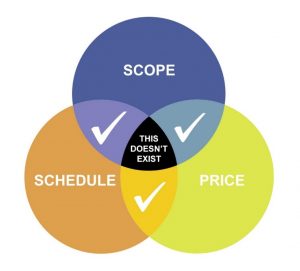Troubled Projects: Part 2 – Using Construction Best Practices
This is the second in a three-part series dealing with problems in construction projects. Here in part two, we discuss what it means to be “in trouble” in the first place, and the construction best practices for maximizing your chance of success. In the first part, we highlighted trends facing the design and construction industry and the challenges they present as building owners try to advance projects; and the third and final post of this series will outline strategies for dealing with construction problems once they occur. While some items and examples apply primarily to public sector projects, the principles hold true regardless of the project type.
Are We Really In Trouble? What Does It Mean, and How Can I Avoid It?
Every construction project can be defined by three elements: Scope (what is included), Schedule (how long will it take), and Price (how much does it cost). Within Scope, we also consider work quality and functionality, because it’s one thing to say you want a new bathroom, but if the tile is crooked, the paint is sloppy, and the water doesn’t run, it’s not a construction project problem you really want to pay for.
 While it would be terrific if a project was able to deliver on all three elements, the reality is that achieving all three (a project of highest quality scope, at the lowest price, done in the least amount of time) is just about as rare as witnessing a meeting of Bigfoot, a unicorn, and the Loch Ness monster. If a project needs to be expedited, then it’s not unlikely that the price would go up and/or the quality might decrease. Similarly, to achieve the best quality product, the task will either take a bit longer or cost a bit more (or both). And for the lowest-cost result, quality may suffer while the project drags on.
While it would be terrific if a project was able to deliver on all three elements, the reality is that achieving all three (a project of highest quality scope, at the lowest price, done in the least amount of time) is just about as rare as witnessing a meeting of Bigfoot, a unicorn, and the Loch Ness monster. If a project needs to be expedited, then it’s not unlikely that the price would go up and/or the quality might decrease. Similarly, to achieve the best quality product, the task will either take a bit longer or cost a bit more (or both). And for the lowest-cost result, quality may suffer while the project drags on.
It is important to understand which of these three project elements is your guiding light, and which is the one that can give (if needed). Of course the aim is to hit all three, but if your entire project team has the same understanding of which element can’t be sacrificed for any reason, then decisions can be made easier and quicker, and your metrics of success can be achieved. And conversely, your project can be considered to be “in trouble” when your primary goal is threatened.
Construction Best Practices: Avoid Trouble In The First Place
Before we discuss how to preventatively plan and avoid trouble in each of the three project elements, we should mention that the overarching consideration is your Owner-Contractor contract. Ultimately this is the document that outlines how you deal with trouble when it occurs, so it’s absolutely critical that your contract is clear on the responsibilities of all parties. The American Institute of Architects (AIA) publishes a series of contracts which have become the industry standard, providing boilerplate documents which can be easily modified to suit your particular needs. However, by using AIA contract structure, there is a high degree of familiarity among your contractor, your architect, and your legal counsel; so parties understand where information is contained and how the contract ties back to the front end bid specifications. Utilizing the industry standard as your basis helps all parties navigate the contract with ease and familiarity, building upon a series of widely accepted construction best practices.
Best Construction Practice: Schedule
There are two components to your project’s schedule. The first is the design and bid/procurement phase. By meeting early with your architects and design team, you can collectively put together a schedule that suits your needs. Preferably, there is plenty of time to get everything done, though real world conditions and unforeseen construction project problems may make your project somewhat less than ideal.
- If schedule is your pain point, then bid your project early. Beyond the immediate benefit of starting sooner, know that there is a “bidding season,” where if your project is bid too late, you risk a smaller pool of potentially less skilled contractors and higher prices. Get in front of the pack, and have your contractor on board to start as soon as possible. Also consider coordinating with other projects that are out to bid in the marketplace, so that you’re not forcing bidders to choose between your project and someone else’s.
- Realize that many building components have very long lead times. HVAC equipment, doors, windows, and casework all take weeks if not months to manufacture – once the order is placed. Know that contractors need to do their own field measurements and shop drawing preparation, and your architects and engineers need to review their plans, prior to ordering. So planning on a 16 week lead time for an HVAC unit starting on the day you award a bid does not account for several of those necessary steps in the process.
- Consider phasing your project or having work performed off-hours. If your completion date is fixed, think strategically about how you might get there. Contractors working two or three crews at a time isn’t always the answer; laying that new wood gym floor means that you can’t have twenty other contractors simultaneously in the space working on running ductwork and painting the ceiling. So think creatively; phasing your work may cost a few dollars more, but if you’ve set schedule as your primary project goal, that may be a choice you need to make to achieve completion within your timeframe.
- Put together a series of milestone dates. Without micromanaging your contractors or dictating their means and methods, make sure there are critical check-ins so you can have assurances that things are moving, and you won’t get to the eleventh hour with half of the work left to be done. Utilize your architect to monitor this schedule, so they can assist the contractor in their efforts to recover any lost time. Ultimately though, realize that the contractor is the entity who controls when their work is done, since you can’t direct their subcontractors or workers, or physically bring them to your site to work.
Best Construction Practice: Scope and Quality
“That’s not what I thought it would look like.” Not a sentence you want to be saying at the conclusion of your construction project. You want to understand what you’re getting, how it will work, and how it will benefit you (if it won’t benefit you in some way, shape, or form, then consider not doing the project at all).
- Understand your project scope. Sit down with your architect and make sure you realize what will be happening. What gets removed, what is going in its place, how will everything be put together? Your architect is putting together drawings, but there are really two different sets of drawings during the design phase. The first, a Design Development set, is intended to make you, as the Owner, understand the project. This is something you should be willing to sign off on; if you’re not, then perhaps there is still something unclear, and why not work through that while your project is still in the drawing stage? After the design is signed off on, then your architect puts together more detailed construction documents, which are your contractor’s instructions.
- Investigate your existing conditions. Whether you’re dealing with a new office building on untouched soil, or an existing 1950s school, know what you’re dealing with. Consider going beyond standard visual reviews and doing exploratory testing or digging. Get into the ground, above the ceilings, perhaps utilize ground penetrating radar to find pipes, conduits, or other hidden components that may not be documented anywhere else. Performing this due diligence up front minimizes the chance of surprises during construction, when the solution can cause all sorts of cost and schedule delays.
- Pay attention to what’s going on around you. Your team should be knowledgeable and experienced. If a construction worker is cutting corners or not performing, consider asking your contractor to make a change in personnel. Think about having your architect increase the number or frequency of their site visits if you’re concerned about your contractor’s work. And ask questions if you don’t understand something.
Best Construction Practice: Price
The old saying “money makes the world go ’round” rings true in construction projects. It is to the contractor’s benefit to purchase their materials and labor for as little as they can, and charge you as much as they can. That’s not to paint a picture of contractors as evil corporations, single-mindedly focused on their bottom line; but realize that even the best and most altruistic contractor out there can’t operate at a loss.
- Understand your scope and schedule. Yes, scope, schedule, and price are three somewhat separate concepts; but both scope and schedule greatly influence price. “Off the shelf” or easily obtainable materials will usually cost less than custom pieces, and allowing a contractor unfettered access to their work area during regular working hours will keep more dollars in your pocket than having them start, stop, and work off hours. Keep these concepts in mind as you’re making your design decisions.
- Alternative procurement strategies may help reduce your cost. Eliminating a contractor’s markup by buying components yourself, or purchasing through a cooperative pricing system, may help shave some dollars and cents off of your bill. Know that this strategy transfers risk back to you, though, as you’ll be asking the contractor to install something that they didn’t purchase. They’ll also not be responsible if your items are delayed or arrive damaged.
- Allowing your contractor some latitude and choice in the products they provide helps them give you the best price. Open, non-proprietary specifications mean that your contractor can choose from among a variety of materials, as long as certain minimum standards are met.
Understanding your project’s success metrics is key. It can help streamline and focus your decision making process, and can allay panic when trouble seems like it’s lurking around every corner.
Look for the final part of this series to be posted on the news section of our website in the coming months. In the meantime, let SSP apply our construction best practices to your next project. Contact us today!


